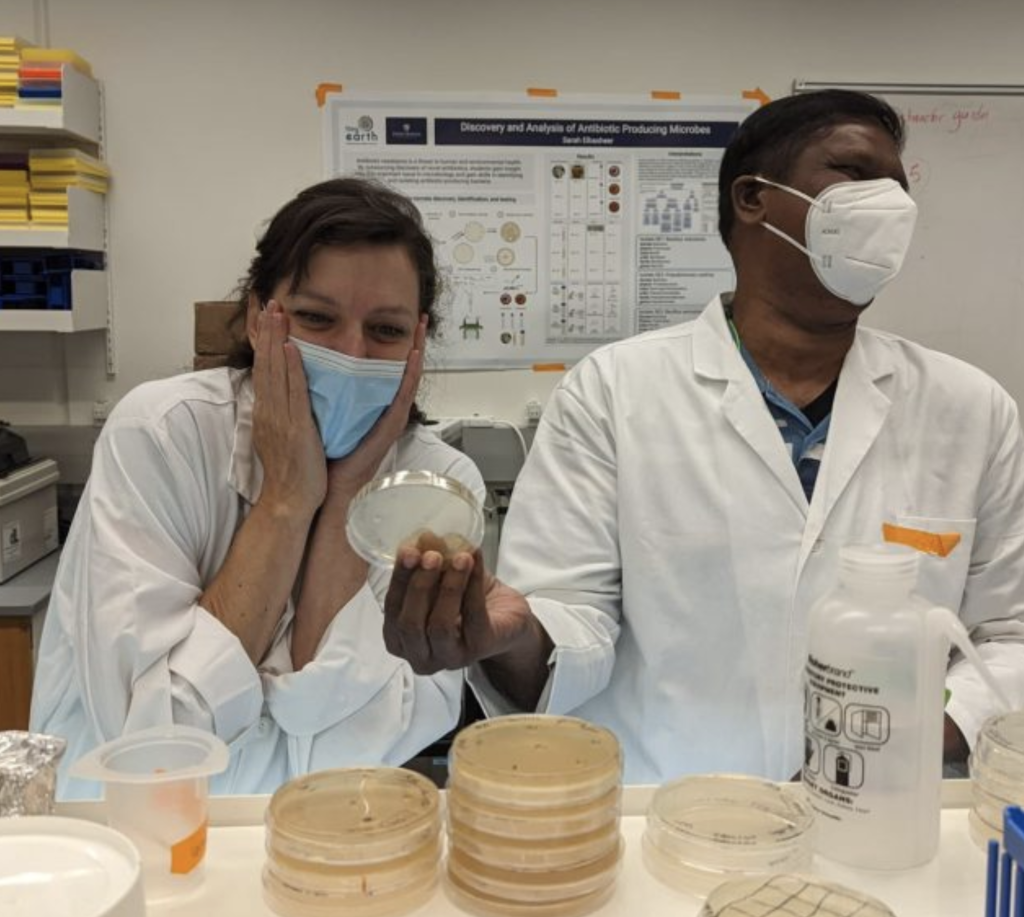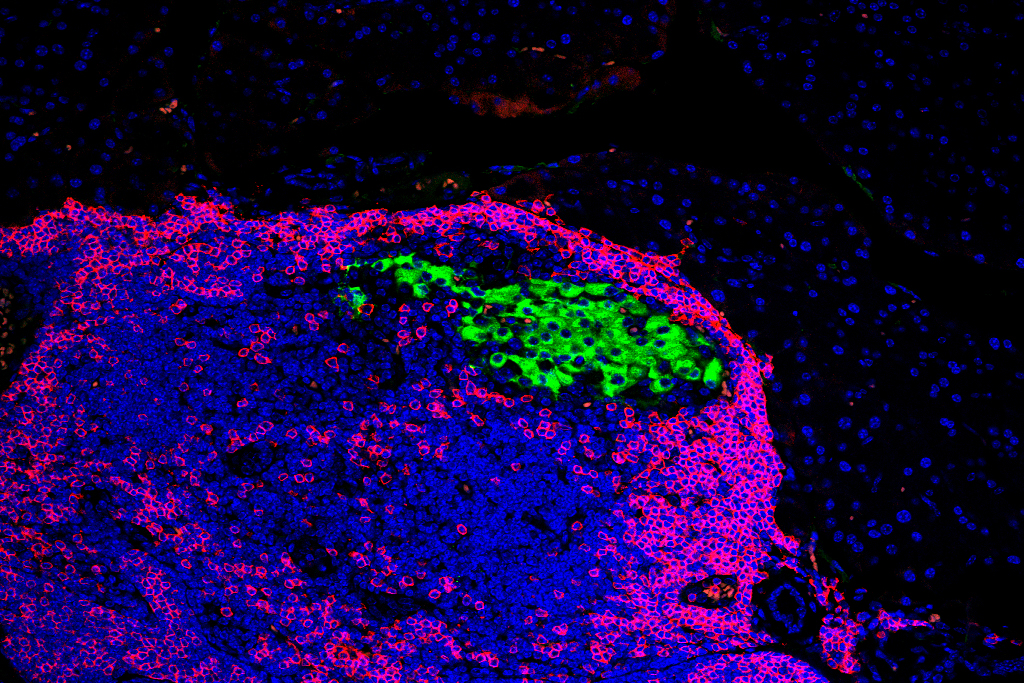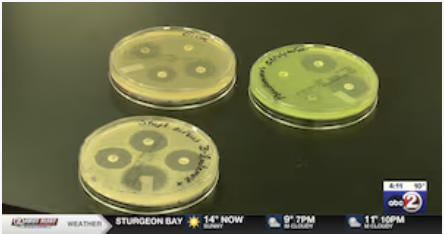Federal Earmark Expands Student-led Search for New Antibiotics

Tiny Earth students enjoy CURE based courses
Around the world in institutions and schools large and small, a new generation of scientists committed to diversification seek to discover new antibiotics through authentic research experiences for college students. Thousands of students (estimated 16,000 annually in 30 countries) who have gone through the Tiny Earth curriculum, an initiative headquartered within the Wisconsin Institute for Discovery at the University of Wisconsin-Madison, will be joined by thousands more, thanks to Congressionally Directed Community Project Funds. Tiny Earth is one of the recipients in the $1.7 trillion federal spending package that passed through the U.S. Congress this past December and was signed into law by President Biden. The Wisconsin-based, global effort is slated to receive $1 million to expand and reach more students.
“This type of investment provides so many benefits! It provides a direct pathway for students at any college to become scientists and expand the search for new antibiotics,” says Sarah Miller, Director of Tiny Earth at UW–Madison.
Tiny Earth is a unique course-based undergraduate research experience (CURE), that focuses on two urgent problems: the antibiotic-resistance crisis and the lack of diversity in the STEM workforce. Antibiotic-resistant infections are predicted to cause 50 million deaths by 2050. To address this crisis, Tiny Earth students discover antibiotic-producing bacteria from soil. They design their own experiments and research questions, choose their own soil and growth media, analyze their data, and communicate their research findings with poster presentations at symposiums, held in person and online. The curriculum embodies the six hallmarks of a CURE – scientific research, iteration, ownership, relevance, discovery, dissemination – which are also hallmarks of scientific research and discovery.
Tiny Earth seeks to address the lack of diversity in STEM. College students leave STEM majors at alarming rates, citing poor teaching methods and lackluster research experiences – if they can find any at all. The majority of those who leave have the interest and ability to succeed, but when early classroom experiences dampen their interest, students switch majors. The attrition rates are higher for students who belong to communities that have been historically underrepresented in science: 42% of white students, 58% of Latine students, and 66% of Black students leave science before graduation. Diversity in STEM industries is important because it brings together different perspectives, creates better experiences and generates better results and innovations.
“This is an equity problem. It’s also not a new problem. But thanks to an ever-growing body of evidence about what works, we have the tools we need to fix the college science pipeline. CUREs like Tiny Earth are at the top of the list.” – SMM
Creating a sense of belonging has been shown to improve persistence and retention of diverse students in STEM. CUREs such as Tiny Earth have been shown to increase retention of students – especially underrepresented students – by providing access to meaningful engagement with science and research. CUREs also make research accessible because everyone enrolled in the course gets to do the research, not just a few students at a research university mentored by a faculty member. Tiny Earth takes this one step further, incorporating inclusive learning practices that have been shown to improve self-confidence, scientific identity, and a sense of belonging in STEM.
Funding from the Earmark will support training for instructors to learn the laboratory skills for research with their students and the teaching skills for building inclusive communities of student researchers in their classrooms. Training more instructors to teach Tiny Earth will increase the rate of discovery of new antibiotics, while reducing inequity in college STEM education. Furthermore, improving diversity among college graduates will strengthen Wisconsin’s growing workforce in the fields of biotechnology, information technology, and engineering locally and globally.
“Every college should have at least one CURE so every student can give scientific research a try.” – SMM

Sarah Miller
The Tiny Earth expansion was made possible thanks to support from Senator Tammy Baldwin and Representative Mark Pocan.“Today is a great day for Wisconsin. This funding legislation provides a major investment in our schools, healthcare, workers, and infrastructure,” said Pocan in a statement announcing the passage of the bill. “These projects will reach every corner of the district and I look forward to seeing the impact of these projects for years to come.”
Scientific-related earmarks are rare; they usually fund regional economic development projects. After earmarks were reinstated last year, lawmakers inserted a fraction of the thousands of accounts that fund government activities to fund research. Though small in the overall scope of the $1.7 trillion-dollar budget, having the US Congress boost spending on earmarks to universities is a boon to the mission of Tiny Earth and the rising generation of students facing these challenges head-on.
Schools & Colleges in Wisconsin Where Tiny Earth Has Been Taught
Alverno College
Beloit College
Blackhawk Technical College
Carthage College
Chippewa Valley Technical College
College of Menominee Nation
Edgewood College
Fox Valley Lutheran High School
Fox Valley Technical College
Indian Mound Middle School
Lakeshore Technical College
Madison Area Technical College
Marian University
Marquette University
Mid-State Technical College
Milwaukee Area Technical College
Milwaukee Public Schools
Milwaukee School of Languages
Mount Mary University
Northcentral Technical College
Northeast Wisconsin Technical College
Northeast Wisconsin Technical College – Green Bay
Oak Creek West Middle School
Parker High School
Spring Harbor Middle School
St. Norbert College
University of Wisconsin – Eau Claire
University of Wisconsin – Fond du Lac
University of Wisconsin – Green Bay
University of Wisconsin – Green Bay, Manitowoc
University of Wisconsin – Madison
University of Wisconsin – Milwaukee, Washington County
University of Wisconsin – Oshkosh
University of Wisconsin – Parkside
University of Wisconsin – Platteville
University of Wisconsin – Platteville, Baraboo Sauk County
University of Wisconsin – River Falls
University of Wisconsin – Rock County
University of Wisconsin – Stout
University of Wisconsin – Superior
University of Wisconsin – Waukesha
University of Wisconsin – Whitewater
Vincent High School
Waukesha County Technical College
-Laura C. RedEagle









